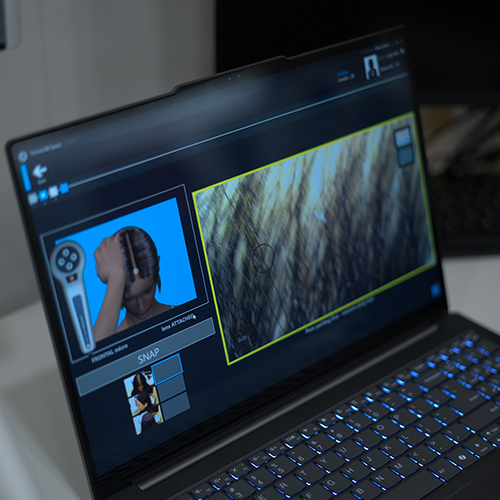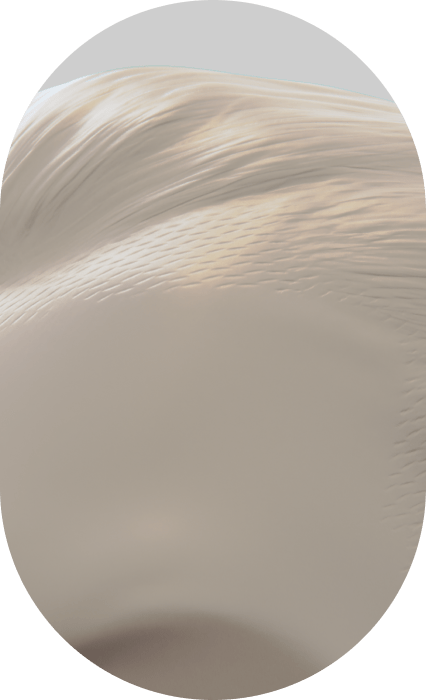Cicatricial Alopecia
Once hair follicles have scarred, it’s rare that they can be restored. That’s why it’s imperative that you get any sudden or unexpected hair loss checked out as early as possible by the best doctor in Manhattan. When you have an autoimmune condition that requires cicatricial alopecia treatment, you have a much greater chance at regrowing lost hair if you begin the scarring alopecia treatment in the earliest stages. Otherwise, your options for hair restoration become limited. Call the experts in New York City at our hair restoration office today for an evaluation.

What Is Cicatricial Alopecia?
Cicatricial alopecia is a form of hair loss in which your hair follicles are targeted by a destructive inflammatory process or an autoimmune disorder, leading to hair loss and follicle scarring. Also referred to as scarring alopecia, it’s a form of permanent hair loss because scarred hair follicles can’t regrow once they’re destroyed. Since hair loss is emotionally disconcerting, this form of alopecia can be especially upsetting because it’s permanent. It’s less common than nonscarring alopecia.
If you’re seeking scarring alopecia treatment in New York City, rely on the expertise of a top hair transplant doctor at Linkov Hair Surgery. You’ll find hair loss treatments at the best price, whether you need scarring alopecia treatment, non-scarring alopecia treatment or treatment for another type of hair loss, such as:


What Are the Symptoms of Cicatricial Alopecia?
If you have cicatricial alopecia, you usually lose your hair in patches. It may happen suddenly and progress quickly, or it may develop slowly over the course of several years. Along with hair loss, you may experience:
- Itching
- Tenderness
- Crusting or scaling
- Pustules
- Burning
- Bleeding
- Redness or discoloration
In most people, this condition affects hair on the scalp, but it can strike any area of the body with hair, including eyebrows and eyelashes. As hair follicles are destroyed, they’re replaced with fibrous scar tissue. Not everyone with scarring alopecia notices signs of inflammation. Inflammation occurs below the surface skin, which is why you need to seek a definitive diagnosis and treatment for scarring alopecia from the best doctor in NYC.

What Causes Scarring Alopecia?
The actual cause of scarring alopecia isn’t well understood, but it appears to be related to an inflammatory process. Other factors that contribute to this condition include:
- Fungal infection
- Mechanical traction
- Hair relaxers and other chemicals
- Burns
Cicatricial alopecia isn’t hereditary and it’s not contagious. It can affect both men and women, but rarely occurs in children. Scarring alopecia is less common than non-scarring alopecia, which has many possible causes, such as:
What Are the Different Types of Cicatricial Alopecia?
Cicatricial alopecia is divided into two categories: primary and secondary. Primary scarring alopecia means hair follicles are directly targeted and destroyed due to an inflammatory or autoimmune condition. Secondary scarring alopecia happens because of damage to your skin from an injury, such as a burn, tumor or severe infection. The types of primary cicatricial alopecia include:
- Lichen planopilaris This is the most common form of scarring alopecia. It mostly affects women between the ages of 40 and 60, and it’s a condition that affects skin and mucous membranes, causing itching, burning and scaling.
- Frontal fibrosing alopecia This form of cicatricial alopecia looks like a receding hairline and affects mostly post-menopausal women.
- Central centrifugal cicatricial alopecia In this condition, hair loss starts at the crown of your head and gradually widens. It usually affects black women and starts around age 30.
Chronic cutaneous lupus erythematosus is a form of scarring alopecia caused by lupus, an autoimmune disorder that causes inflammation throughout your body. Lupus can directly trigger hair loss and damage to your skin, or medications prescribed to treat the disease cause the damage
What Options Do I Have for Cicatricial Alopecia Treatment?
The best treatment for cicatricial alopecia depends on the cause, including the specific type of scarring alopecia you have and what type of inflammatory cells are attacking your hair follicles. Treatment options include:
Corticosteroids Steroid injections and topical steroids reduce inflammation in your hair follicles.
Anti-inflammatory medication Your doctor may prescribe anti-inflammatory medication, such as hydroxychloroquine to fight the inflammatory cells.
Antibiotics When bacteria have caused your scarring alopecia, your doctor may prescribe oral antibiotics.
Minoxidil This medication, often sold under the brand name Rogaine, but also sold as generic brands, stimulates hair regrowth from remaining unscarred follicles.
Platelet-rich plasma therapy In this form of treatment, blood plasma, containing high amounts of platelets from your own body, supplies the healing power to help tissues heal. In some forms of hair loss, this treatment promotes new hair growth and increases hair density. It may be effective for certain types of scarring alopecia.
Hair replacement systems If you have any form of hair loss and are self-conscious about your appearance, you may benefit from using a hair replacement system, such as a hairpiece, wig or toupee.
Hair follicles can’t regenerate once they’re destroyed, but if you treat inflammation early enough, you can control the inflammatory process, sometimes making it possible to regrow hair before follicles are irreversibly damaged. There’s no cure for cicatricial alopecia, so treatment for scarring alopecia aims to slow or stop your hair loss.
Some types of hair loss benefit from a hair transplant, a surgical procedure in which hair is moved from your back or another area to the place where you’ve had hair loss. This form of treatment isn’t usually recommended for cicatricial alopecia treatment. In some individuals, although it may be considered if the alopecia has been inactive for over a year or if you’ve experienced more than one type of hair loss.
Do I Have Scarring Alopecia?
Your NYC doctor determines the cause of your hair loss by doing a physical exam and reviewing your medical history. Blood work may be necessary to check for other conditions that cause hair loss, since a thyroid imbalance, anemia or diabetes may be responsible for triggering hair loss. A skin biopsy confirms the diagnosis of scarring alopecia.
If you notice increased hair shedding or scalp redness, burning or irritation, get evaluated by a top NYC hair restoration doctor with expertise in scalp and hair disorders. Many forms of hair loss, including scarring alopecia, obtain the best results from treatment when diagnosed early. For an evaluation by the best hair loss doctors in Manhattan, contact Linkov Hair Surgery today. They’re familiar with the most up-to-date treatment options available.
Linkov Hair Surgery
150 E 56th St, #1A
New York, NY 10022
(212) 970-9404

